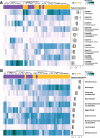A comparative study of the gut microbiota in immune-mediated inflammatory diseases-does a common dysbiosis exist?
- PMID: 30545401
- PMCID: PMC6292067
- DOI: 10.1186/s40168-018-0603-4
A comparative study of the gut microbiota in immune-mediated inflammatory diseases-does a common dysbiosis exist?
Abstract
Background: Immune-mediated inflammatory disease (IMID) represents a substantial health concern. It is widely recognized that IMID patients are at a higher risk for developing secondary inflammation-related conditions. While an ambiguous etiology is common to all IMIDs, in recent years, considerable knowledge has emerged regarding the plausible role of the gut microbiome in IMIDs. This study used 16S rRNA gene amplicon sequencing to compare the gut microbiota of patients with Crohn's disease (CD; N = 20), ulcerative colitis (UC; N = 19), multiple sclerosis (MS; N = 19), and rheumatoid arthritis (RA; N = 21) versus healthy controls (HC; N = 23). Biological replicates were collected from participants within a 2-month interval. This study aimed to identify common (or unique) taxonomic biomarkers of IMIDs using both differential abundance testing and a machine learning approach.
Results: Significant microbial community differences between cohorts were observed (pseudo F = 4.56; p = 0.01). Richness and diversity were significantly different between cohorts (pFDR < 0.001) and were lowest in CD while highest in HC. Abundances of Actinomyces, Eggerthella, Clostridium III, Faecalicoccus, and Streptococcus (pFDR < 0.001) were significantly higher in all disease cohorts relative to HC, whereas significantly lower abundances were observed for Gemmiger, Lachnospira, and Sporobacter (pFDR < 0.001). Several taxa were found to be differentially abundant in IMIDs versus HC including significantly higher abundances of Intestinibacter in CD, Bifidobacterium in UC, and unclassified Erysipelotrichaceae in MS and significantly lower abundances of Coprococcus in CD, Dialister in MS, and Roseburia in RA. A machine learning approach to classify disease versus HC was highest for CD (AUC = 0.93 and AUC = 0.95 for OTU and genus features, respectively) followed by MS, RA, and UC. Gemmiger and Faecalicoccus were identified as important features for classification of subjects to CD and HC. In general, features identified by differential abundance testing were consistent with machine learning feature importance.
Conclusions: This study identified several gut microbial taxa with differential abundance patterns common to IMIDs. We also found differentially abundant taxa between IMIDs. These taxa may serve as biomarkers for the detection and diagnosis of IMIDs and suggest there may be a common component to IMID etiology.
Keywords: 16S rRNA gene amplicon sequencing; Bacteria; Gut microbiota; Immune-mediated inflammatory disease; Inflammatory bowel disease; Machine learning classifiers; Multiple sclerosis; Rheumatoid arthritis; Taxonomic biomarkers.
Conflict of interest statement
Ethics approval and consent to participate
Written informed consent was obtained from patients and healthy controls prior to sample collection. The University of Manitoba’s Research Ethics Board approved this study.
Consent for publication
Not applicable.
Competing interests
The authors declare that they have no competing interests.
Publisher’s Note
Springer Nature remains neutral with regard to jurisdictional claims in published maps and institutional affiliations.
Figures




References
-
- Wraith DC. The future of immunotherapy: a 20-year perspective. Front Immunol. 2017;8. Available from: https://www.ncbi.nlm.nih.gov/pmc/articles/PMC5712390/. Cited 15 Mar 2018. - PMC - PubMed
Publication types
MeSH terms
Substances
LinkOut - more resources
Full Text Sources
Other Literature Sources
Medical

